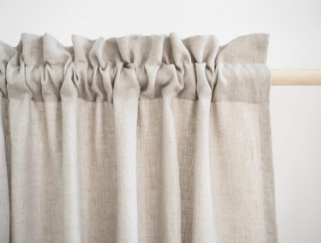Curtains (2) - What style will work for you?
Curtains is such a big topic we have had to divide it into a couple of different blogs. Today is installment two of what you need to know before investing in curtains.
There are a few different headers you can get on a curtain and each one will give you a different look. (The header is the large hem at the top that attaches to the rod). There are many ready-made curtains on the market these days and many of them have the pocket rod header. This is a channel along the top of the curtain that when the rod slips through has gentle gathering, which makes for a very casual look. I think these would work well for a rental place or perhaps a cottage or anywhere you don’t really need high quality curtains. These curtains have no real control system; you just pull the panels over to cover the window, so they are often best suited for curtains that will stay in place as shimmying them over the rod can be challenging. They are inexpensive because they are the easiest type of header to make and use no more hardware than the rod. These can be found at most big box stores these days in varying lengths.
Along the same lines would be the tab curtain panels. Pretty much everything that we said about the pocket rod curtain panel will also apply with the tab curtain panels.
An inexpensive curtain option example - a pocket rod header. Image: So-linen.com
A variation of the pocket rod header - this has a 2” header above the rod. Image: So-linen.com
Another budget friendly option is the tab top header. Image: So-linen.com
Pinch Pleats is a very common type of header. There are many variations on this header from wide box pleats to more narrow pencil pleats. It is considered a more formal header as it is more structured but could be used in a contemporary setting particularly if the hardware is contemporary. You will need to use a hook and glider of some sort to use this header which will make the curtain panel flow easily across the rod. This type of curtain uses more fabric than the pocket rod curtain and if lined, these curtains feel like they have a lot of substance which can really add to the layering of fabrics in a room.
A beautiful example of pinch pleats being used in this dining room. Image: 3hlinen.com
My favourite type of header these days is the ripple fold header. It uses a bit less fabric than the traditional pinch pleat but it still uses enough to make them substantial. They can sit right up under the rod sytem if you don’t want to use the ring and hook. It is a more contemporary look but I have used it in more traditional settings to give a more updated current look to a space and it has been very effective.
This modern S-fold style typical from the Ripple fold style, creates a sophisticated look. Image: Classicmodernhome
What about the rod? What type should you use? Again, so many different ideas here so we will narrow it down a bit.
When going for a very casual look, you could use a wooden rod with simple finials (the piece that attaches to each end of the rod). This would work well for a casual, cottage type application. Very often I will use a metal rod that ties into the other metals in the room. If the door hardware is oil rubed bronze then using that same finish on the curtain rod will help keep the look cohesive. With either of these rods you will need rings and hooks if using the pinch pleat curtain. These rods are called decortive rods as they add to the decoration of the room.
Curtain rods come in many different options and finishes, here are examples of wood and metal tones. Image: West Elm
My favourite type of rod to use these days is called the channel rod. This hides all the hooks and gliders inside the rod so that the curtain fabric can sit right up against the rod. This will work well for both pinch pleats and ripple fold. It is definitely a more current, contemporary look but I do feel there is longevity in this look as it has been around for a few years now and has no hint of disappearing anytime soon.
An example of a channel rod system. Image: Tonic Living
With all of these decorative rods I will use fling rods. Because these rods don’t generally come with side pulley systems to opereate the curtain I will use these rods to operate the curtain. If you don’t use fling rods then you will have to pull on the curtain fabric to open and close it. This may, over time, cause some staining on the inside hem from the oils on your fingers. Fling rods are long rods that hang on the inside of the inside panels. You can pull on these to operate the curtains and they work very well.
If your room has a valance in place then a track rod system will work well. The valance hides all the hardware so you don’t need a decorative rod which is more costly than the simple track. Another advantage of the track is you can have the pulley system on the side which can make for easier opening and closing of the curtains.
As you can see there is a lot to know about curtains. Hopefully this will start you on the path of knowing what will work for you in your space.
Are you Ready to Get Started on Your Design Project?
Brooke Hatfield Design can guide you through the process of your interior design project and make it as effortless as possible.








